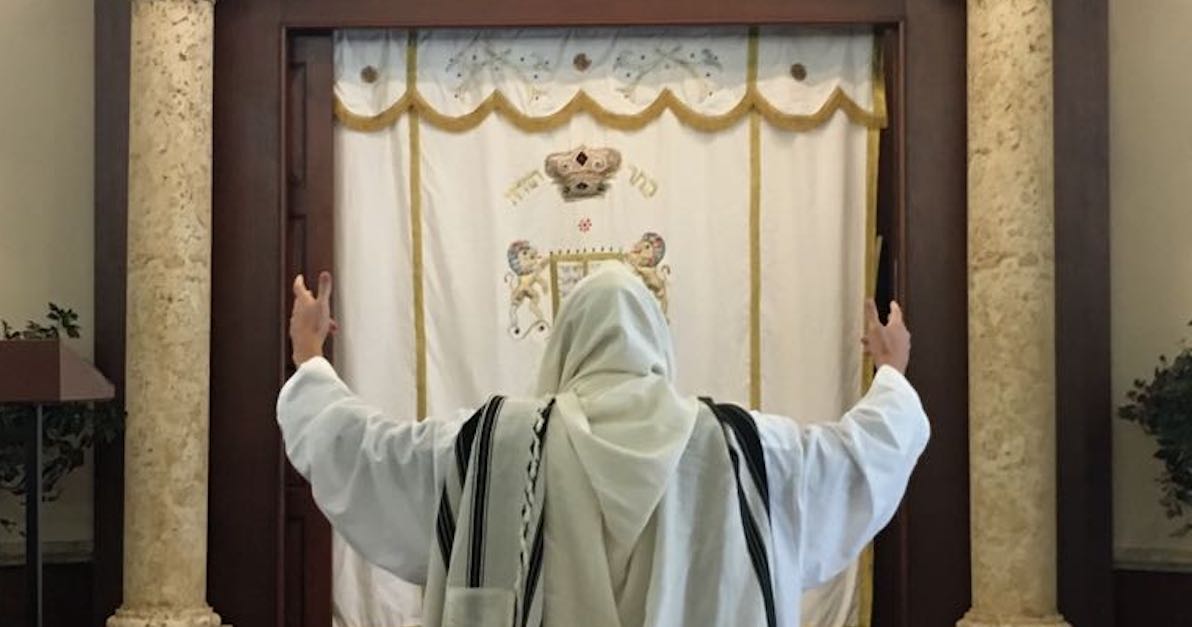From weddings to Yom Kippur, the kittel symbolizes purity and solemnity in Jewish culture. Find out more about this unique garment and its meaning.
A Kittel (Yiddish: קיטל) is a white robe (White Shroud) that is worn by observant Jewish men on certain occasions.
The most well-known occasion for wearing a Kittel is during the High Holy Days, which include the Jewish New Year (Rosh Hashana) and the Day of Atonement (Yom Kippur). During these solemn and introspective days, the Kittel is worn as a symbol of purity and repentance, reminding the wearer of the need to examine one’s deeds and strive for spiritual growth and improvement.
The Kittel is also worn by Jewish grooms on their wedding day. In this context, it symbolizes hope for a new beginning and a life of purity and devotion to one’s spouse and God.
The Kittel is typically made of plain white fabric, such as cotton or linen, and is worn over other clothing. It has long sleeves and is fastened with buttons or ties at the neck. The garment is often embroidered with a Hebrew phrase or symbol, such as the words “holy to God” (קדוש לה’) or the Star of David.
In Jewish tradition, wearing the Kittel is a reminder of the fleeting nature of life and the need to constantly strive for righteousness and holiness. It also symbolizes the hope for redemption and the ultimate triumph of good over evil.
When do you wear a Kittel?
The Kittel is worn on many important holidays and occasions in the Jewish calendar and during certain life cycle events. Here are some of the occasions when a Kittel is traditionally worn:
- Yom Kippur: The Kittel is most commonly associated with Yom Kippur, the Day of Atonement, when Jews seek forgiveness for their sins and strive to renew their commitment to a life of righteousness.
- Passover Seder: On the first night of Passover, some Jews wear a Kittel during the Seder, the ritual meal commemorating the Exodus from Egypt.
- Weddings: The groom traditionally wears a Kittel during the wedding ceremony, symbolizing the purity and holiness of the marital union.
- Brit Milah: During a Brit milah, or circumcision ceremony, the mohel (ritual circumciser) may wear a Kittel as a sign of purity and devotion to God.
- Shabbat and High Holidays: Some observant Jews wear a Kittel on Shabbat and other High Holidays as a sign of their devotion and commitment to religious observance.
What High Holy days do you wear it?
The Kittel is traditionally worn on two of the most essential High Holy Days in the Jewish calendar: Rosh Hashanah and Yom Kippur.
Rosh Hashanah, also known as the Jewish New Year, marks the beginning of the Jewish calendar and is a time of reflection, repentance, and renewal. It is celebrated over two days and is a time for introspection and prayer. Some Jews wear a Kittel during the Rosh Hashanah services (special services) as a sign of their devotion and commitment to a life of righteousness.
Yom Kippur, the Day of Atonement, is the holiest day of the Jewish year and is a time of fasting, prayer, and repentance. It is a day when Jews seek forgiveness for their sins and strive to renew their commitment to righteousness. The Kittel is worn by many Jews on Yom Kippur as a symbol of purity and holiness and a reminder of the solemnity and gravity of the day.
The Kittel’s association with these High Holy Days reflects their importance in the Jewish calendar and the emphasis on spiritual renewal and commitment that characterizes these days.
The history of the Kittel

Image source: https://www.chabad.org/library/article_cdo/aid/4829/jewish/Why-Do-We-Wear-a-White-Kittel-on-Yom-Kippur.htm
The history of the Kittel dates back to medieval times, although its exact origins have yet to be discovered. The garment is believed to have been adopted by Jews in Europe during the Middle Ages when white robes were commonly worn by Christian priests and monks.
Over time, the Kittel became associated with Jewish religious observance and developed distinctive symbolism and meaning. The white color of the Kittel came to represent purity and holiness, and the garment was often worn by Jewish scholars and rabbis during prayer and study.
The Kittel gained added significance during the High Holy Days, symbolizing the hope for forgiveness and renewal. According to Jewish tradition, during these days, God judges the deeds of all human beings, and the Kittel serves as a reminder of the need to examine one’s actions and strive for repentance.
In the Jewish wedding ceremony, the Kittel is also a symbol of purity and holiness, reflecting the importance of the marital union as a spiritual partnership.
Today, the Kittel remains an essential garment in Jewish tradition, worn by observant Jewish men on various occasions. It is often passed down from generation to generation as a family heirloom, and its significance and meaning continue to be an essential part of Jewish religious practice and identity.
What does it symbolize?
The Kittel carries several symbolic meanings in Jewish tradition:
- Purity: The white color of the Kittel represents purity and holiness, reminding the wearer of the need to strive for moral purity and righteousness.
- Repentance: During the High Holy Days, the Kittel serves as a reminder of the need for repentance and atonement, as Jews seek to examine their deeds and strive to improve themselves in the eyes of God.
- Hope for renewal: The Kittel also symbolizes hope, representing the belief that it is never too late to change and seek redemption. It is a reminder that even in difficult circumstances, there is always the possibility of renewal and a fresh start.
- Equality: The Kittel is a simple and unadorned garment worn by all men, regardless of their social status or wealth. Thus, it symbolizes equality before God and the importance of humility and modesty.
- Spiritual partnership: In the Jewish wedding ceremony, the Kittel represents the spiritual partnership between husband and wife as they embark on a journey of mutual support, respect, and devotion.
Is it used during a burial?

Image source: https://chabadjapan.org/jewish-burial-in-japan/
Yes, the Kittel is also used as a burial shroud in some Jewish communities. In this context, the Kittel symbolizes the deceased’s purity and spiritual readiness to meet their maker.
According to Jewish tradition, the deceased are buried in simple white garments, without any jewelry or other adornments, as a sign of humility and equality before God. The Kittel is, therefore, a fitting garment for use as a burial shroud, as it embodies these values of simplicity and purity.
Is it worn on Shemini Atzeret?
The Kittel is not traditionally associated with Shemini Atzeret, but it is worn by some Jews on this holiday and on Simchat Torah, which immediately follows Shemini Atzeret.
Shemini Atzeret is a Jewish holiday that falls on the eighth day of Sukkot and is traditionally considered a separate holiday in its own right. It is a day of rest and spiritual renewal, including special prayers and rituals.
While the Kittel is not explicitly associated with Shemini Atzeret, it is worn by some Jews on this holiday as a sign of their devotion and commitment to religious observance. It is also worn on Simchat Torah, which celebrates the completion of the annual cycle of Torah readings and the beginning of a new cycle.
The Kittel’s association with these holidays reflects their importance in the Jewish calendar and the emphasis on spiritual renewal and commitment that characterizes these days.
What is a Kittel made from?
The Kittel (cotton Robe) is typically made from a lightweight, breathable, comfortable fabric (simple Linen Clothes). Cotton, linen, or a blend are the most common materials used to create a Kittel.
The fabric is usually a plain white Linen, although some Kittels may be embroidered with simple designs or Hebrew phrases. The embroidery may be done by hand or by machine and may include symbols such as the Star of David or the word “holy to God” (קדוש לה’).
The Kittel is designed to be loose-fitting and comfortable, allowing for ease of movement during prayer and other religious rituals. It typically has long sleeves and is fastened with buttons or ties at the neck.
Because of its symbolic importance, the Kittel is often treated with great care and respect by its wearers. It may be passed down from generation to generation as a family heirloom and laundered and stored in a particular way to preserve its purity and spiritual significance.
Recommend0 recommendationsPublished in Opinion
Responses